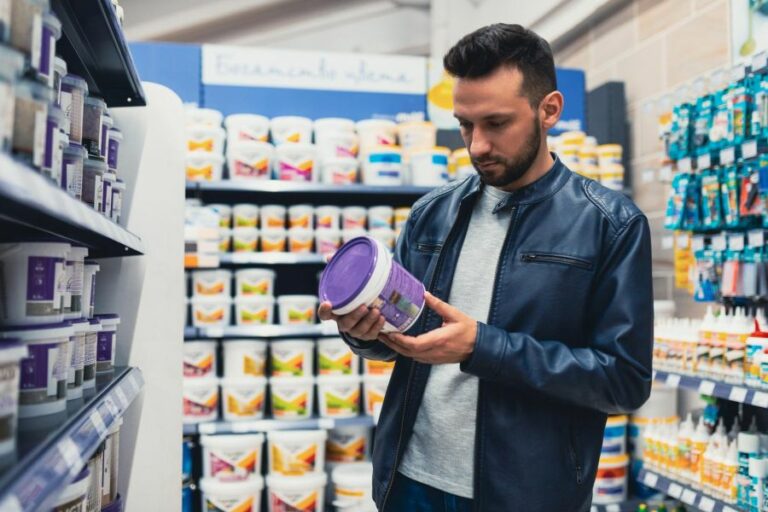Sustainable Paint For Interiors, 25 Things You Should Know
Choosing the right paint for your interiors is not just about picking the perfect color anymore; it’s also about making a conscious choice to minimize our impact on the environment. That’s where sustainable paint options come into play. With my expertise, I can guide you towards eco-friendly alternatives that not only beautify your living spaces but promote a healthier and greener lifestyle.
Sustainable paint for interiors:
Sustainable paint options for interior spaces include low-VOC and zero-VOC paints, natural paints, and recycled paint. These eco-friendly alternatives contribute to healthier indoor air quality and less environmental impact. When choosing sustainable paint, consider factors such as VOC content, natural ingredients, recycled content, certifications, durability, and overall performance.

Discover the world of sustainable paint for interiors and learn how to make a positive impact on the environment while transforming your living spaces. Read on for eco-friendly paint choices, application tips, and much more. Don’t miss out on this green revolution in home decor!
Contents
- 1 Eco-Friendly Interior Paint Solutions
- 2 Discover the Top Eco-Conscious Paint Options
- 3 The Reality of Environmentally Friendly Paint
- 4 Alternatives to Traditional Paint for Eco-Friendly Homes
- 5 Environmental Impact of Interior Paint Choices
Eco-Friendly Interior Paint Solutions
As global awareness about the importance of sustainability and eco-friendly living continues to grow, more and more people are considering the environmental impact of everyday products.
One such area where sustainability is becoming increasingly important is in the world of interior design and, more specifically, paint.
• The Environmental Impact of Traditional Paint
Before delving into sustainable paint options, it’s essential to understand the environmental impact of traditional paint. Traditional paint typically contains volatile organic compounds (VOCs), which can release toxic chemicals into the air when applied to walls.
These chemicals can contribute to air pollution, climate change, and potential health concerns for those in close proximity.
To promote healthier indoor air quality and reduce environmental impact, sustainable and eco-friendly paint options have been developed.
• Low-VOC and Zero-VOC Paints
One of the simplest ways to make paint more sustainable is to reduce or eliminate VOCs. Low-VOC paints contain significantly reduced levels of VOCs compared to traditional paint, making them a more eco-friendly alternative.
Zero-VOC paints, as the name suggests, contain no VOCs, making them an even better option for sustainability and indoor air quality.
While low-VOC and zero-VOC paints can be more expensive than traditional paint, they typically offer similar performance in terms of coverage, durability, and color range. Additionally, the long-term benefits of improved indoor air quality can help offset the higher initial cost.
• Natural Paints
Another sustainable paint option is natural paints, which are made from renewable and biodegradable materials. Ingredients in natural paints can include plant oils, water, chalk, clay, and other natural pigments.
Some benefits of natural paints include the complete absence of toxic chemicals and VOCs, as well as a lower overall environmental impact due to the use of renewable resources. However, natural paints can be more expensive and may not offer the same level of durability as their synthetic counterparts.
• Recycled Paint
As the name suggests, recycled paint is made using leftover or unused paint that has been collected, processed, and then repurposed into new paint. By recycling paint, we can significantly reduce waste and conserve resources compared to producing new paint.
Recycled paint typically has a lower environmental impact than virgin paint, as it prevents waste from ending up in landfills and reduces the need for raw materials. However, the quality and performance of recycled paint can vary depending on the source and the manufacturing process.
• Choosing the Right Sustainable Paint
When selecting a sustainable paint for your interior spaces, there are several factors to consider:
- VOC levels: Opting for low- or zero-VOC paints can greatly improve indoor air quality and reduce environmental impact. Be sure to check the label or product specifications for VOC content before purchasing.
- Natural ingredients: Look for paints made with natural materials and avoid those containing harmful chemicals or toxins. This is particularly important in spaces where children or individuals with chemical sensitivities may be present.
- Recycled content: Choosing paint with a high percentage of recycled content can help reduce waste and conserve resources. Check the product labels or ask the manufacturer about the recycled content in their paint.
- Certifications: Look for paints that hold third-party certifications, such as Green Seal or EcoLogo, which award products based on their environmental impact and performance. These certifications can lend credibility to a product’s sustainable claims.
- Durability and performance: While sustainability is essential, it’s also crucial to choose a paint that performs well and lasts. Consider the overall quality, coverage, and durability of the paint in addition to its eco-friendly attributes.
• Final Thoughts
Incorporating sustainable paint into your interior design can greatly reduce your environmental impact and improve indoor air quality.
By considering factors such as VOC content, natural ingredients, recycled content, certifications, and overall performance, you can make an informed decision about the best sustainable paint for your needs.
With an ever-growing number of eco-friendly options on the market, it’s easier than ever to go green with your interior paint choices.
Discover the Top Eco-Conscious Paint Options
When it comes to choosing paint, it’s essential to consider not only the desired color and finish but also the environmental impact of the product. Traditional paints often release harmful chemicals into the air, which can result in health problems and negative effects on the planet.
As a result, there’s been a growing interest in finding the most environmentally friendly type of paint.
• The Importance of Choosing Eco-Friendly Paint
Despite the popularity of conventional paints, it’s crucial to recognize the potential harm they cause to both humans and the environment. Many traditional paints contain volatile organic compounds (VOCs), which can lead to respiratory problems, headaches, and dizziness when inhaled.
Additionally, the production and disposal of these paints contribute to air and water pollution. By opting for a more environmentally friendly type of paint, you can help reduce these negative effects.
• Low-VOC and Zero-VOC Paints
One of the best ways to choose a more environmentally friendly paint is by looking for products labeled as low-VOC or zero-VOC. These paints reduce the amount of harmful chemicals emitted into the air, making them healthier options for both people and the environment.
– Low-VOC Paints
Low-VOC paints contain fewer volatile organic compounds than traditional paints, reducing the negative health and environmental effects. These paints still emit some VOCs but in significantly lower amounts.
I recommend selecting paints that meet the standards set by environmental agencies such as Green Seal, meaning they contain less than 50 grams of VOCs per liter for flat finishes and less than 150 grams per liter for non-flat finishes.
– Zero-VOC Paints
If you want to go a step further, zero-VOC paints eliminate the release of volatile organic compounds altogether. Keep in mind that adding colorants to these paints may still introduce VOCs, so it’s important to also select zero-VOC colorants.
Several manufacturers produce zero-VOC paints, providing a range of options for eco-conscious consumers.
• Natural Paints
Another option for environmentally friendly paint is to opt for natural paints. These paints are made from natural, renewable ingredients such as plant oils, beeswax, and mineral pigments.
Because they use raw, biodegradable materials, these paints typically have a minimal environmental impact during both production and disposal.
– Milk Paint
One popular type of natural paint is milk paint, which is made from simple ingredients such as milk protein, lime, and pigment. This paint has been used for centuries and can create a beautiful, durable finish on various surfaces.
Milk paint is available in both powdered and premixed forms, giving users the flexibility to mix as much or as little paint as needed for their project.
– Clay Paint
Clay paint is another environmentally friendly option that uses a clay-based binder and natural pigments. This paint can create a unique, textured finish and is particularly suitable for interior walls.
It’s also a great choice for those looking to improve indoor air quality, as clay paint helps control humidity and absorbs air pollutants.
– Lime Paint
Lime paint is made from natural, slaked lime and mineral pigments. This paint type creates a breathable, durable finish that’s ideal for both interior and exterior surfaces. Lime paint helps prevent moisture and mold buildup, making it perfect for areas prone to dampness or high humidity.
• Tips for Choosing Eco-Friendly Paint
When searching for the most environmentally friendly paint, consider the following tips:
- Look for paints labeled as low-VOC, zero-VOC, or natural. These paints release fewer harmful chemicals into the air and are generally better for the environment.
- Seek reputable certification labels such as Green Seal or EcoLogo, which indicate that the paint meets strict environmental and performance criteria.
- Choose paint with high-quality, natural ingredients that are renewable and biodegradable.
- Opt for durable paints to reduce the need for frequent repainting, thus minimizing waste and environmental impacts.
Ultimately, the most environmentally friendly type of paint for your project will depend on your specific needs and preferences. By considering the options available, such as low-VOC, zero-VOC, or natural paints, you can make a more sustainable choice and reduce your environmental footprint.
Type of Paint | Environmental Benefits |
|---|---|
Water-Based Paints / Latex Paints | Low VOCs, easy clean-up, less harmful chemicals |
Milk Paints | Biodegradable, non-toxic, made from natural ingredients |
Clay Paints | Free of VOCs, made from natural materials, recyclable packaging |
Lime Paints | Absorbs CO2, reduces mold and bacteria, made from natural materials |
Mineral Silicate Paints | Extremely durable, UV-resistant, inorganic and solvent-free |
The Reality of Environmentally Friendly Paint
In recent years, there has been a growing concern for the environment, and many people have started to search for ways to reduce their individual carbon footprint.
One way to achieve this is through the use of eco-friendly and sustainable materials in our homes, including paints. But is there such a thing as eco-friendly paint? The answer is: yes!
• The Importance of Eco-Friendly Paints
Traditional paints can contain harmful chemicals, such as volatile organic compounds (VOCs), which can evaporate into the air and cause air pollution. In addition, they can lead to various health problems, including headaches, dizziness, and more severe issues like respiratory illnesses and even cancer.
By opting for eco-friendly paints, we can reduce our exposure to these harmful substances and contribute to a healthier and cleaner environment.
• Types of Eco-Friendly Paints
There are different types of eco-friendly paints available in the market today. Some of the most common ones include:
– Water-Based Paints
In contrast to solvent-based paints, which contain high VOC levels, water-based paints use water as the primary solvent. This means that they emit fewer VOCs during the drying process, making them more environmentally friendly.
Additionally, water-based paints tend to be low-odor and have faster drying times.
– Natural Paints
Natural paints are made from raw ingredients such as clay, plant oils, and minerals. These paints do not use synthetic chemicals, which makes them a popular choice among eco-conscious individuals. Some common examples of natural paints include clay paints, lime washes, and milk paints.
– Zero- or Low-VOC Paints
These paints are specifically designed to reduce or eliminate the presence of VOCs, making them an excellent choice for individuals concerned about their impact on the environment and indoor air quality. Many paint manufacturers now offer zero- or low-VOC options in their product lines.
A great resource for finding low-VOC paints is the EPA’s Indoor airPLUS website, which provides a list of compliant products.
– Recycled Paints
Recycled paints are made from surplus paint that has been collected, processed, and remanufactured into new paint products. By using recycled paints, we can help reduce the waste generated from surplus paint disposal and support the circular economy.
• Choosing the Right Eco-Friendly Paint
When selecting eco-friendly paint for your home, there are several factors to consider, including the paint’s ingredients, certification, and cost.
– Ingredients
The first step in choosing eco-friendly paint is to examine the ingredients list. Look for paints made from natural and renewable materials, and avoid those containing harmful chemicals like VOCs and heavy metals.
– Certification
To ensure that the paint you are considering is indeed eco-friendly, look for certifications such as Green Seal, GreenGuard, or Cradle-to-Cradle. These certifications have rigorous standards for environmental impact and can help provide assurance that the paint is truly eco-friendly.
– Cost
While eco-friendly paints may sometimes be more expensive than their traditional counterparts, the long-term benefits for your health and the environment often outweigh the initial cost. Additionally, with the growing demand for eco-friendly products, prices are becoming more competitive.
• Application Tips for Eco-Friendly Paints
Applying eco-friendly paint is similar to working with conventional paint but may require some adjustments. Here are some tips to consider:
- Ensure proper ventilation during the painting process to avoid the buildup of VOCs, even if using low- or zero-VOC paints.
- If using natural paints, such as clay or lime-based paints, follow the manufacturer’s instructions closely. These paints may require a specific application technique or temperature and humidity conditions.
- Plan your painting schedule to minimize waste. Determine the exact amount of paint needed for your project, and store any leftover paint properly for future use or recycling.
• In Conclusion
The world of eco-friendly paints is diverse and ever-expanding. With a wide range of types and growing accessibility, it has become easier than ever to make environmentally-conscious choices in our home improvement projects.
When considering eco-friendly paint options, carefully evaluate the ingredients, certifications, and costs to select the best paint for your needs. By doing so, you can not only create a beautiful living space but also contribute to a cleaner and healthier environment for all.
Alternatives to Traditional Paint for Eco-Friendly Homes
With growing concerns about the environment and the harmful effects of certain chemicals on human health, many people are seeking eco-friendly alternatives in various aspects of their lives. One such area where sustainable alternatives are being researched and used is the world of paints.
• Understanding the Harmful Effects of Traditional Paints
Traditional paints contain a high level of volatile organic compounds (VOCs), which, when released into the environment, can be hazardous to human health and contribute to the pollution of air and water systems.
These VOCs are emitted as the paint dries and can continue to be released for years after the paint has been applied. Some of the harmful effects of VOCs include:
- Irritation to eyes, nose, and throat
- Allergic reactions and asthma
- Long-term exposure can lead to liver, kidney, and central nervous system damage
For this reason, it is essential to consider eco-friendly paint alternatives that reduce the presence of VOCs and other harmful substances in the environment, subsequently enhancing the health and safety of those exposed to these paints.
• The Different Types of Eco-Friendly Paint Alternatives
There are several eco-friendly paint alternatives available, each offering unique benefits and environmental advantages. Some of the most popular options include:
– Water-Based Paints
As the name suggests, water-based paints use water as the primary solvent, making them a much more environmentally friendly alternative to traditional oil-based paints. These paints have a significantly lower VOC content and are less toxic overall.
One of the most popular water-based paint options is latex paint, which is easy to apply and clean up after use. Latex paints also provide excellent durability and a smooth finish.
The United States Environmental Protection Agency (EPA) recommends using water-based paints with low to no VOC content as a safer and environmentally friendly option.
– Plant-Based Paints
Plant-based paints are made using natural ingredients derived from renewable sources like soy, linseed oil, and minerals. They have zero to minimal VOC content and are biodegradable, making them an eco-friendly alternative to traditional paints.
These paints also offer excellent performance, with good durability and a rich, vibrant color range. However, it is essential to note that some plant-based paints may take longer to dry compared to other options.
– Milk Paints
Milk paint is a powder-based paint made from milk protein (casein), limestone, clay, and natural pigments. This ancient paint formula has been around for centuries and offers several eco-friendly benefits, such as:
- Contains no VOCs or harmful chemicals
- Biodegradable and non-toxic
- Unique, rustic finish ideal for furniture and antique restoration
Milk paint can be a more labor-intensive option, as it requires mixing and preparation before application. However, the end result is a beautifully textured and earthy finish that is both safe and eco-friendly.
– Recycled Paints
To reduce waste and support the reuse of materials, many companies now offer recycled paint options. These paints are made from leftover paint collected from various sources, such as construction sites and paint manufacturers.
The paints are then filtered, mixed, and reformulated to create new colors and finishes.
Using recycled paints helps to minimize the environmental impact of paint production by reducing waste, conserving resources, and reducing energy consumption. It is important to look for recycled paint products with low VOC content and third-party certification to ensure quality and safety.
• How to Choose the Right Eco-Friendly Paint Alternative
When selecting an eco-friendly paint alternative, consider the following factors:
- VOC Content: Opt for paints with low or zero VOC content to minimize harmful emissions and improve indoor air quality.
- Certifications: Look for independent certifications, such as Green Seal, Greenguard, and Ecolabel, which indicate that a product meets specific environmental and health standards.
- Performance: Ensure that the paint is durable, long-lasting, and has a suitable finish for your project.
- Color Range: Some eco-friendly paint alternatives may have limited color options. Be sure to verify the availability of colors that fit your design aesthetics.
- Availability: While eco-friendly paint alternatives are becoming more widely available, some options may not be easily accessible in your area. Be prepared to research and compare multiple suppliers to find the best paint for your needs.
• Final Thoughts
Using eco-friendly paint alternatives is an excellent way to reduce the harmful effects of traditional paints on the environment and individuals’ health. By choosing water-based, plant-based, milk, or recycled paints, we can make conscious choices that contribute to a healthier and more sustainable future.
When selecting an eco-friendly paint, remember to consider the VOC content, certifications, performance, color range, and availability to ensure that you choose the best option for your needs.
With a growing selection of eco-friendly paint alternatives, there has never been a better time to make a positive change for the environment and our living spaces.
Environmental Impact of Interior Paint Choices
When it comes to home improvement and design, choosing the right paint for your interior walls is of utmost importance. Not only does paint dictate the atmosphere and visual appeal of a space, but it also has the potential to impact the environment.
This raises the important question: is interior paint harmful to the environment?
• Various Types of Interior Paint on the Market
Before analyzing the environmental impact of interior paint, it is essential to understand the different types available.
– Oil-Based Paints
Oil-based paints were once the norm for both interior and exterior applications. However, they are currently less popular due to their high levels of volatile organic compounds (VOCs) and difficult cleanup process.
– Water-Based Paints
Water-based paints, including latex and acrylic, are now more commonly used for interior applications. They emit fewer VOCs, are easier to clean up, and offer faster drying times.
– Low-VOC and Zero-VOC Paints
Many paint manufacturers now offer low-VOC and zero-VOC paints to help reduce the environmental impact.
– Natural and Organic Paints
Natural and organic paints are made from plant-based, mineral, and clay ingredients, making them a more environmentally friendly option.
• Environmental Effects of Interior Paint
– Volatile Organic Compounds (VOCs) and Air Quality
One of the primary concerns with interior paint and its impact on the environment is the release of VOCs. VOCs are organic chemicals that evaporate from paint as it dries, releasing pollutants into the air.
According to the United States Environmental Protection Agency (EPA), VOCs can contribute to a range of health issues, such as respiratory problems, headaches, and dizziness. Moreover, they can also contribute to the formation of ground-level ozone, which is a major component of smog.
– Waste Management
During the painting process, waste is generated in the form of empty paint cans, rollers, and brushes, which can end up in landfills. If not adequately disposed of, leftover paint can leak chemicals into the surrounding environment.
– Energy Consumption
The production of paint requires significant energy consumption, contributing to greenhouse gas emissions. Furthermore, natural resources are required to make paint, such as petroleum for oil-based paints, which may contribute to resource depletion.
• Tips for Choosing Environmentally Friendly Interior Paint
– Opt for Low-VOC or Zero-VOC Paints
To minimize your environmental impact, I recommend selecting low-VOC or zero-VOC paints. These options have fewer harmful chemicals and emit less pollution during the application process.
– Choose Water-Based Paints Over Oil-Based Paints
Switching to water-based paints, such as latex or acrylic, can help reduce both VOC emissions and the demand for petroleum-based products.
– Properly Dispose of Paint and Painting Supplies
Ensure that you dispose of your paint and painting supplies in accordance with your local waste management guidelines. This helps prevent chemical contamination of the environment.
– Use High-Quality, Durable Paints
Investing in high-quality paint typically translates to better durability and coverage, reducing the need for frequent repainting or touch-ups. As a result, fewer resources are consumed in the long run.
– Consider Natural or Organic Paints
Explore the option of using natural or organic paints, which are made from more sustainable and eco-friendly materials. These paints often have fewer VOCs and require less energy to produce.
• Conclusion
Interior paint can have a lasting impact on the environment through the release of VOCs, waste generation, and energy consumption. By making conscious choices, such as selecting low-VOC, water-based, or natural paints, you can help minimize this impact while still achieving a beautiful interior space.







